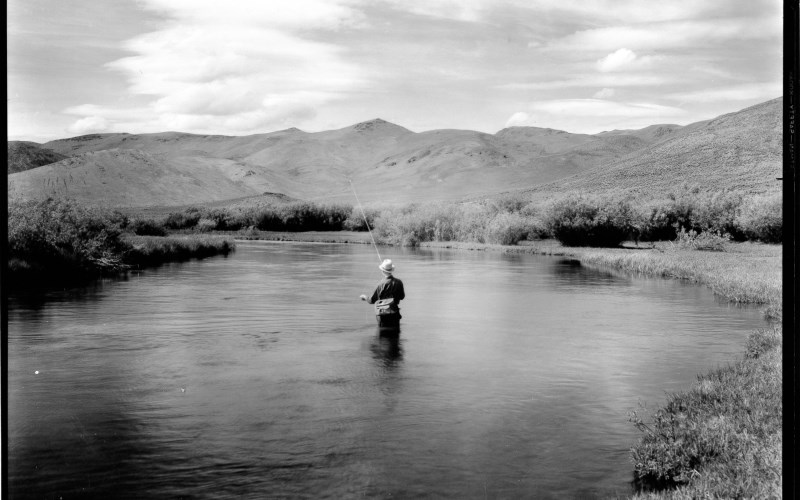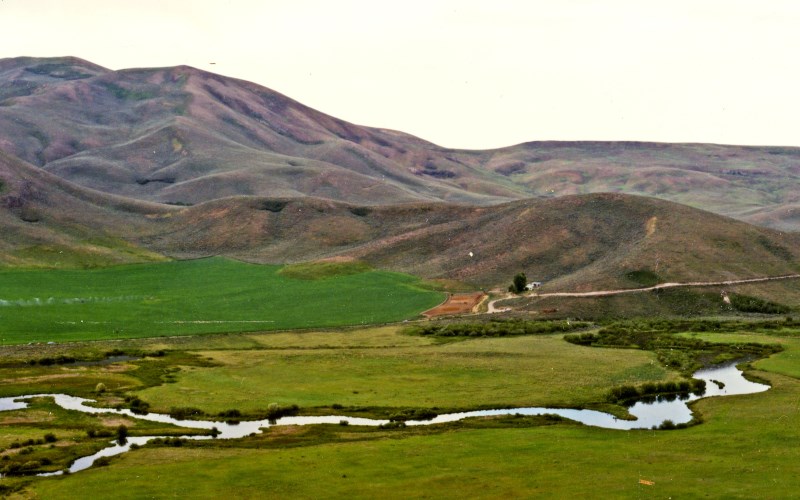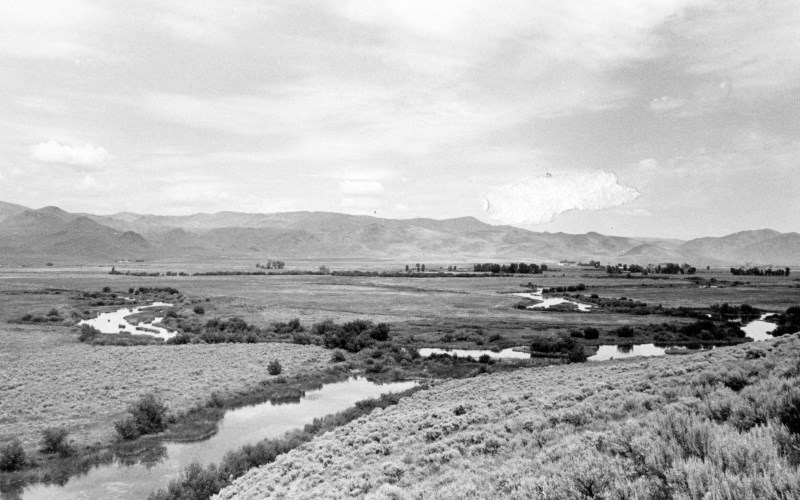|
BY JOHN W. LUNDIN Averell Harriman initially planned Sun Valley to be a ski resort open only in the winter. But, once it opened during the winter of 1936-37, it remained open in the summer of 1937, and summers became a strong season, attracting vacationers from all over the country. Sun Valley offered guided fishing and hunting trips under head guide Taylor Williams, along with guided horseback trips, golf, tennis, swimming, ice skating and even polo for the well-to-do sportsmen. The Sun Valley rodeo was also a popular summer activity in a brand spanking new rodeo grounds said by the New York Times to be “the West’s most modern sports stadium.” Hunting and fishing at Silver Creek were popular activities for Sun Valley guests from the resort’s beginning, and its high-altitude spring waters played an important role in Sun Valley’s early days.
|
|

This picture shows that the biggest changes to Silver Creek over the years is the hat and fisherman gear. COURTESY: John Lundin and The Community Library
|
|
|
Louis Holliday, who was working at the Union Pacific station in Omaha, Neb., recounted stopping at Silver Creek while taking the train from Omaha through Shoshone to Ketchum in late October and early November of 1936: “We left Shoshone at 5:30 in the morning on the train and pulled into Ketchum at 3:30 in the afternoon. The engineer and brakeman stopped the train to talk to farmers along the way. They would get out their guns and shoot a couple of ducks and pheasants on Silver Creek. Very interesting. Half of the windows in the car we were in were broken out. By the time we got there, there were two guys ready to go back to Omaha.” The New York Times of May 30, 1937, reported that Sun Valley was developing a “year-round center with tennis courts and outdoor swimming pools, horseback treks through mountains, fishing in lakes and streams rarely visited by the sportsman.” Fishing will take place in “unmapped and untamed mountain lakes and streams,” the article continued, “And hunters will find ruffed grouse, elk and mountain goats. Sun Valley Lodge will open on July 1, for the summer vacation season.”
|
|

This photo provides an overhead view of Silver Creek and ranch.
|
|
|
Note that Sun Valley’s ads said it was located in the Sawtooth Mountain Range. While it sounded enticing, it was not correct as the resort is located in the Pioneer Mountains. The Sawtooth Mountains are 60 miles north, over Galena Pass. The resort was located in the Sawtooth National Forest--perhaps the term Sawtooth Mountains sounded sexier for its publicity. One ad noted that, surrounded by 23,000 square miles of untouched wilderness, Sun Valley Resort “provides continental comfort..superb cuisine with a few miles distant the babies of elk, deer, antelope, mountain boat, big horn sheep and mountain lion. No other place so nearly approaches a fisherman’s paradise for here are rainbow, cutthroat, Dolly Varden, steelhead trout, redfish, landlocked and ocean run salmon And, unheard of, a fishing school for beginners.” On June 12, 1938, the New York Times reported on “Summer Plans at Sun Valley,” describing the wide array of activities available: “There will be horseback riding, swimming, fishing, skeet shooting, and golf on the new course laid out in Trail Creek Canyon, as well as excursions into the hinterlands. Later in the season a five-day trip by saddle and pack horse will take fishermen into the unmapped White Cloud and Salmon River areas scarcely ever before fished by white men...Just below Sun Valley is spring-fed Silver Creek, where rainbow trout are large and plentiful. The less adventurous fisherman can stick close to home and fish by twilight in the clear waters of Sun Valley Lake.”
|
|

This older photo provides another overhead view. COURTESY: John Lundin and The Community Library
|
|
|
The Valley Sun, Special Summer Edition described Sun Valley’s summer of 1939. A new 60 x 120-foot outdoor ice-skating rink was opened, overlooked by the dining terrace at the Lodge with a “generous dance floor” which could be used in winter or summer. New tennis courts were built. Summer rodeos started in August in “the most modern western sports stadium ever created...Rodeo Stadium Finest in the West.” The resort offered swimming, badminton, paddle tennis, croquet, bicycling, canoeing, horseshoes, archery, golf on a “tricky” new nine-hole course with 18 tees, trail riding, fishing in local streams and at Silver Creek and pack expeditions into the nearby wilderness area. In Fall 1939 a man who became closely associated with Sun Valley--Ernest Hemingway--came to the resort, fell in love with the area and became a well-known persona there for over 20 years. His network of friends included Hollywood stars and local associates who loved to hunt and fish at Silver Creek. Hemingway was already famous as a novelist, journalist and adventurer. The Sun Also Rises was published in 1926, and A Farewell to Arms in 1929, which was partially based on his time as an ambulance driver in Italy during World War I. A Farewell to Arms, called “the best American novel to come out of World War I,” became Hemingway’s first best seller, ensured his stature as a leading American author and made him financially independent.
|
|

These hunters used a unique kayak to get around in Silver Creek’s earlier days. COURTESY: John Lundin and The Community Library
|
|
|
Gene Van Guilder was a Sun Valley publicist who knew how much the resort gained from publicity about celebrities who stayed there. In 1938, he learned Hemingway spent time in Montana in the fall. He sent an employee to Key West, Fla., to offer him free room and board at Sun Valley in exchange for their right to use Hemingway’s photographs. Hemingway was too busy covering the Spanish Civil War as a journalist to accept the offer. But he came to Sun Valley the next year, arriving without notice. He was still married to Pauline but in the company of Martha Gellhorn, with whom he started an affair in Spain. When he arrived on Sept. 20, 1939, Sun Valley photographer Lloyd Arnold and guide Gene Van Guilder saw “a big man with an attractive blond girl” who looked familiar before realizing it was Hemingway. Publicist Steve Hannagan in New York said to “roll out the red carpet but to do so gently because the famous writer “spooks easily.” Pat Rogers welcomed the couple and took them to room 206, a suite in the Lodge with two bedrooms, each with its own bath and balcony and a living room with a separate balcony. Hemingway endeared himself to Arnold and Van Guilder, discussing hunting and fishing, entering into a “laughing, joking, teasing, friendly, lovable relationship,” according to Larry Morris in his book, Ernest Hemingway & Gary Cooper, An Enduring Friendship.
Hemingway wrote several chapters of For Whom The Bell Tolls in Suite 206, which he called “the Glamour House,” working from dawn to early afternoon. In the afternoons, he went horseback riding, played tennis, or explored Silver Creek near Picabo, which became his favorite hunting spot in Idaho. Evenings consisted of group dinners followed by socializing and alcohol at Glamour House. Hemingway fell in love with the hunting around Sun Valley. He particularly loved bird hunting in the Wood River Valley, on Silver Creek near Picabo, the area around Shoshone, the Pahsimeroi Valley and the Middle Fork of the Salmon River. He associated with movie stars and the rich and famous, but learned to appreciate the local hunting and fishing guides who shared his love of the outdoors. “Hem took unique pleasure in long, animated conversations, sometimes telling stories of his own but more often than not asking questions of others, listening, pondering, asking more questions, and showing an extraordinary interest in the experiences and thoughts of his dinner companions,” said Morris. Hemingway became good friends with Gary Cooper and they became hunting companions, often going to Silver Creek or near Shoshone. When his friend Gene Van Guilder was killed in a hunting accident on Silver Creek in fall 1939, Hemingway was devastated. He wrote a memorial for Van Guilder that was later put on his own memorial on Trail Creek after he took his own life in 1961.
Bud Purdy, owner of a ranch near Picabo through which Silver Creek flows, was a friend of Hemingway’s and did a lot of hunting with him in 1940 and 1941. Purdy said Hemingway never acted like a celebrity, was considerate of others, always wanted someone else to take the first shot, never drank while he hunted and was always polite. For larger hunts, “Gen. Hemingway” would organize parties of more than 20 Hollywood and local friends. Tillie Arnold, who wrote a book about Hemingway, said he did not fish much in Idaho, but he loved the hunting, particularly upland birds. In May 1940, Averell Harriman received a letter from an acquaintance who stayed at Sun Valley from October 1939 to May 1940. He was the kind of wealthy, worldly outdoors man the resort attracted. He commented on the resort’s operations and included criticisms that one does not find elsewhere. Big game hunting was “well organized,” and guide Taylor Williams is “worth his weight in gold,” the critique said. Duck hunting at Silver Creek was “well organized and excellent,” but boats were necessary for hunting on the big reservoirs. Snipe offered “excellent shooting, but should not be offered to anyone unless they are extremely competent and experienced guns.” Pheasant hunting - “very good shooting, but ill organized.”
Sun Valley needed to “acquire sole right to large tracts of farmland near Jerome, Shoshone and Gooding,” the comment continued. $5 should secure 240 acres for a year. Pigeon hunting at Malad Canyon “is a unique sport for America.” Sun Valley should press for a closed season on those unprotected birds. Clay pigeon and target shooting - “well organized, well run.” Guides needed policing. “Except for Taylor, all were more or less deficient in the fundamental requirement of ‘safety first.’ ” Properly trained retrievers “are very badly needed.” Trained pointers would be useful. Guests learning to shoot should use only “ordinary double-barreled guns of a sort they might later be expected to use in civilized shooting abroad,” and never pump-guns. Fishing “is absolutely excellent. More dams were needed on Trail Creek for beginners and boats for fishing on beaver dams would be useful.” EDITOR’S NOTE: Learn of Silver Creek’s expansion under Sun Valley…the man who prompted Ernest Hemingway to pack his things and move from the Sun Valley Lodge to Ketchum…and the reason Sun Valley gave up Silver Creek as we continue John Lundin’s essay in Sunday’s Eye on Sun Valley. More about the history of Sun Valley and Wood River Valley can be found in John W. Lundin’s books, Skiing Sun Valley: A History From Union Pacific To The Holdings, and Sun Valley, Ketchum and The Wood River Valley, as well as his many history essays at the Center for Regional History at The Community Library. His website is https://www.johnwlundin.com/.
|